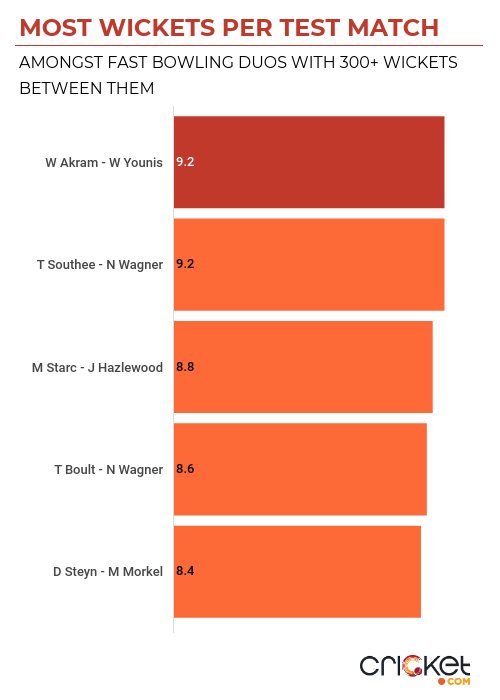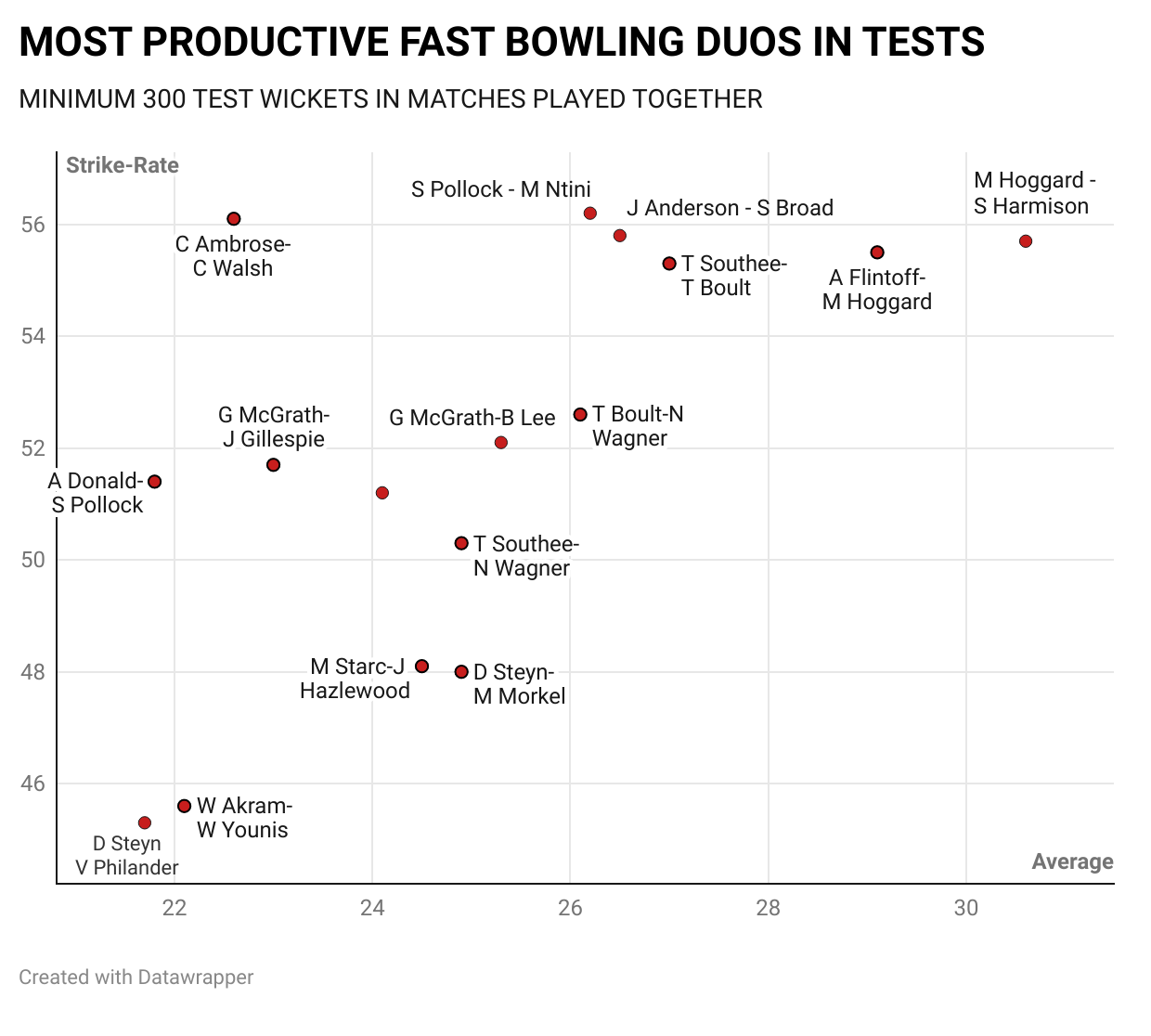News
Wasim Akram and Waqar Younis - The most deadly bowling duo
 OPINION
OPINIONWe analyze how Wasim Akram and Waqar Younis emerge as the most tormenting fast bowling duo to play Test cricket since 1990
Amongst the Asian giants - India, Sri Lanka and Pakistan - it is the latter which enjoys the most successful record outside the sub-continent (in New Zealand, Australia, South Africa, England and West Indies). Pakistan have won more Tests in those countries (36) as compared to India (33) and Sri Lanka (10) while playing a lot less games than their neighbour (164 against India’s 210). Even if you don’t consider the 10 Tests India played before division and independence, 36 Test wins in 164 matches versus 33 wins in 200 Tests only suggests that Pakistan have done something right.
That something has been their bowling. The strongest bowling unit amongst all the Asian sides, especially in the pace department, Pakistan won a majority of games on the back of their pace battery, the main ingredient to win outside the Indian sub-continent. The highest wicket-takers for India, Sri Lanka and Bangladesh are spinners while for Pakistan, the top three spots in that list are occupied by fast bowlers. Their wickets tally is led by arguably the best left-arm seamer of all-time and birthday boy, Wasim Akram.
The tag of the best left-arm seamer is laid against Akram not because he has the most number of wickets by a left-armer, but by virtue of his mastery in all facets of pace bowling. He could swing the new ball, he could swing the old one, he could extract seam movement, he could even follow a corking yorker with a mean bouncer. He achieved all those putting minimal effort.
Akram operated with a short run-up and almost a non-existent follow-through. In between there was a whippy action which instilled the delivery with all the tricks through his inimitable wrist. To create a reference for millennials who did not see Akram bowl, he made bowling look as easy as Rohit Sharma does with his batting nowadays. You want to copy them but you know you can only wish to do so.
From his debut in 1985 till November 14, 1989, Wasim averaged 27.6 in 25 Tests striking every 65.4 deliveries. From then onwards, his numbers improved - bowling average dipped to 22.7 runs per wicket and strike-rate came down to 52.2 balls per dismissal.
Waqar Younis made his debut in the first Test against India which commenced from November 15th, 1989 and formed one of the most iconic Test bowling duos with Wasim. Waqar was different from Wasim. He would come in from a bustling run-up before heading into an open chested slingy action and run-up, but he complemented Wasim perfectly. Their partnership had a clear impact on Pakistan’s Test fortunes and 1990s proved to be the most fruitful decade for Pakistan’s Test cricket.

In the 61 Tests the duplet played together, they plucked 559 wickets. Only two other fast-bowling pairs - Sir Curtly Ambrose-Courtney Walsh (762 wickets) and James Anderson-Stuart Broad (919) - are ahead. However, when it comes to taking wickets-per-match, no one beats Pakistan’s ‘two Ws’ amongst the pairs who thrived in the post 1990 era.

In these 61 Tests in which Wasim-Waqar picked 9.2 wickets per Test, the other Pakistan bowlers have taken 6.9 wickets per game which means the fast bowling duo has taken 25.8 percent more wickets than others. This is a standout figure. The same number for other pairs who come close to Wasim-Waqar in the above graph is 12 percent for Southee-Wagner (8.1 wickets per Test for others), 5.5 percent for Starc-Hazlewood (8.6 wickets per Test). Walsh-Ambrose accounted for 8 wickets per Test, only 3.8 percent more than the others while Anderson-Broad were behind others. The huge margin signifies how Wasim-Waqar stood out.
Their 559 wickets together came at an astonishing rate of 22.1 runs and 45.6 balls per wicket. Few bowling pairs come close to emulating those numbers, especially in terms of strike-rate.

In victories, the strike-rate dipped to an astonishing figure of 37.7 balls per wicket. Imagine the havoc. A wicket approximately every six overs. No time for the opposition to forge a partnership. Only Dale Steyn and Vernon Philander came close to that strike-rate. However, they bettered the bowling average along with another Protea duplet, Shaun Pollock and Allan Donald.

Overall, Pakistan won 28 out of the 61 Tests they played together - a win percentage of 46 under the pace duo. They snaffled 326 wickets in victories - 11.6 wickets per win. Even considering that 20 wickets are required to win a Test and Pakistan took them all to script those 28 victories, there were 560 wickets for the taking. With only 234 wickets left for others - 8.4 wickets per win - Waqar-Wasim pouched more than three wickets per win for Pakistan.
In overseas conditions, their time included Pakistan’s undefeated series-run in Test cricket in England and New Zealand. In those 14 games in England and New Zealand across five tours, they picked 147 wickets together at 23.4 runs and 48.8 balls per wicket. In the one-off Test in New Zealand in 1993, Wasim and Waqar picked 5 wickets each bundling out the Kiwis for 93 while defending a total of 126.
Overall, they picked 330 wickets in 37 overseas Tests at 23.5 runs and 48.8 balls per wicket. In this criteria, once again, there are very few bowling duos challenging them. Australia’s Josh Hazlewood and Mitchell Starc form a menacing combination but have played only 15 Tests outside Australia as yet. Amongst others, only Walsh & Ambrose better them on bowling average while Wasim-Waqar still remain unbeaten in terms of strike-rate.

The only aspect where the Ws fall behind is the quality of wickets in terms of taking the top-order batsmen (number 1 to 7). While most of the bowling duos are in the 70s in terms of percentage of top-order wickets (Glenn McGrath & Jason Gillespie the highest with 76.2 percent top-order wickets), Wasim-Waqar are the lowest at 66 percent amongst fast-bowling duos with more than 300 wickets together. However, this also translates that cleaning the tail was more trivial an issue for Pakistan than other sides.
As mentioned above, Wasim & Waqar were quite distinct in nature. One thing which united them was the art of reverse-swing which they inherited from Imran Khan. It made them relentless even when the ball was old. Both of them were equally effective with little to separate them.
Wasim was better in terms of average (21.3 as compared to Waqar’s 22.9) while Waqar bagged his wickets 7 balls quicker. With his nonchalant approach to the crease, Wasim, who was able to save energy, bowled 372 more overs than Waqar. Out of the 559 wickets they picked together, Waqar accounted for 277 scalps (49.5 percent) while Wasim pouched 282 of those, the difference being a negligible five wickets. The fact that the proportion is not even 49-51 shows how close they were.

As it can be seen, Wasim and Waqar flourish in multiple aspects of fast bowling as a combo. While other bowling pairs nearing them or excelling them in a handful of cases, keep changing, these two have stayed constant everywhere - bowling numbers overall, in wins, in overseas conditions, wickets per Test, standing out from their team-mates and even sharing the wickets amongst themselves almost equally.
However, it was a pity that the two geniuses did not get along off the field. Pakistan cricket, in the 90s, was submerged in controversies and the Wasim-Waqar feud was a major part of it. On the other hand, it augmented the competitiveness between the two to outdo each other which might have been the ingredient that elevated them to the status of the most intimidating fast bowling pair ever.
Note: Shane Warne-Glenn McGrath have taken most wickets as a pair (1,001 wickets in 104 Tests) but combinations involving a spinner are not taken into consideration. Similarly, the combination of Jacques Kallis-Makhaya Ntini and Shaun Pollock-Jacques Kallis have taken 526 and 522 wickets respectively. However, they are not a part of the analysis since Kallis was mostly a support bowler and was in the side largely for his batting. This article was first published on June 3, 2020. It has been updated to stat till June 1, 2021.